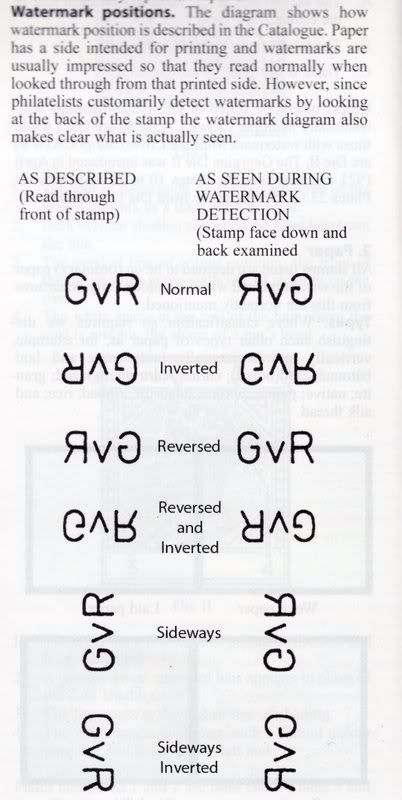Glen,GlenStephens Oct 19, 2011 07:12:48 am in Sydney, Australia escribió:This below is what GIBBONS say about watermarks on ALL their catalogues.
(Bear in mind that Michel (for one) uses the direct opposite system.)
However it shows sideways, normal and reversed watermarks .. and INVERTED versions of all!
this is rather the simplified version which would be OK for most collectors! Whether sideways is the position you get when turning the watermark - supposing it has a readable, upright design at all - clockwise OR when turning it anti-clockwise is the first convention....
Getting a bit deeper into the matter, you need to establish the direction of paper first [Papierlaufrichtung in German] and agree that a sheet of paper [cut from the reel] coming out of the paper machine has that direction coming straight to you when you stand in front of the machine waiting for the sheets to pile up! That is, the direction of paper is vertical when you hold the sheet in front of you taking it from the pile.
We have two different kind of watermarks then! The parallel watermark with the line [GVR] running parallel to the direction of paper or the orthogonal watermark with the line running perpendicular [orthogonal] to the direction of paper.
Having a stamp in a readable position in your hand and looking through it from the back as philatelists usually do you can have the top of the line [GVR] pointing North, East, South or West (or upright, sideways right, upsidedown or sideways left, etc...).
What about the reverse? That is, AЯ instead of RA??? The Argentinean watermark as a handy example.
The RA as a watermark line might have come from the dandy-roll on which AЯ could be read. The paper would get RA on the felt side of the paper, the stamp would get printed on the felt side and so have RA reading from the front and AЯ reading from the back.
But what if the stamp got printed on wire side of the paper? That with the same dandy-roll to start with, we have RA reading from the back!
I know this is making your breathing difficult already!
On the dandy-roll, we can have 4 watermarks to distinguish by looking at the line RA (or GVR):
- RA running along the axis of the dandy-roll cylinder [ortho]
- AЯ running along the axis of the dandy-roll cylinder [ortho]
- RA running along the circumference of the dandy-roll cylinder [para]
- AЯ running along the circumference of the dandy-roll cylinder [para]
Judging our stamps we need to establish the direction of paper - running parallel to the longer side of the stamp [M, major] or parallel to the shorter side of stamp [m, minor]. This can be done for all rectangular stamps whether they have a watermark or not!
What also needs to be done - and this is really the toughest part - is to establish whether the stamp was printed on the felt side or the wire side of the paper! Again, nothing to do with watermarks!
Summing up, you need to realize there can always be 4 types of watermark giving just 1 to an unaware stamp collector - judged from the back of the stamp in 8 different orientations/positions. Just telling that there are eight is an oversimplification
This game can be played with Argentina [RA] and has driven my colleagues there crazy! I am now playing it with my German friends - their DDR watermarks... And also years ago with Israel - the running stag watermark; the Polish trumpet... The CofA or the GvR watermarks haven't even been touched be me really yet!
to be continued ...

